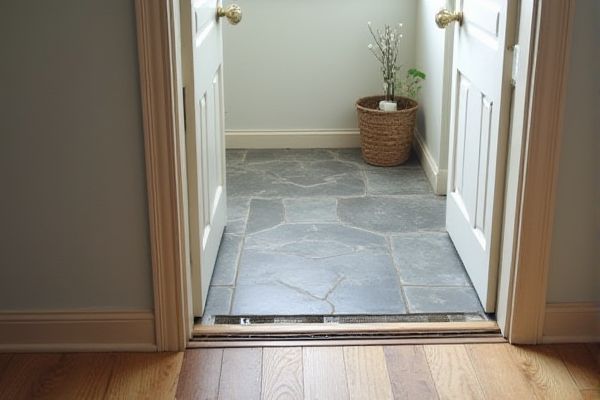
A mudroom floor drain effectively prevents water accumulation and protects your flooring from dirt and moisture damage, while a mudroom without a floor drain may require more maintenance to keep the area dry and clean. Discover how choosing the right drainage option can enhance the functionality and durability of your mudroom in the rest of this article.
Table of Comparison
| Feature | Mudroom with Floor Drain | Mudroom without Floor Drain |
|---|---|---|
| Water Management | Efficiently channels water away, preventing puddles and flooding. | Water can accumulate, leading to dampness and possible damage. |
| Maintenance | Easier cleaning; spills and mud can be quickly drained. | Requires manual mopping and drying, increasing upkeep time. |
| Durability | Protects flooring from water-related wear and rot. | Greater risk of water damage and mold growth over time. |
| Installation Cost | Higher initial cost due to plumbing and drainage setup. | Lower upfront cost without plumbing requirements. |
| Resale Value | Adds value by improving function and durability. | Minimal impact on resale, possible negative if water damage occurs. |
| Ideal Usage | Best for wet climates, high traffic mudrooms, or homes with pets/kids. | Suitable for dry climates or low-traffic entries. |
Introduction to Mudroom Floor Drains
Mudroom floor drains provide an effective solution for managing water, mud, and debris, preventing moisture buildup and potential damage to your flooring. Installing a floor drain in your mudroom ensures efficient water drainage from wet shoes, umbrellas, and pets, maintaining a cleaner, safer space. Without a floor drain, excess water can pool, increasing the risk of mold, mildew, and costly repairs over time.
Purpose and Benefits of a Floor Drain in the Mudroom
A floor drain in the mudroom effectively prevents water damage by channeling excess moisture, mud, and spills away from flooring, reducing the risk of mold and structural issues. It simplifies cleaning and maintenance, ensuring your mudroom stays dry and hygienic despite heavy foot traffic or wet weather. Investing in a floor drain enhances the overall durability and functionality of your mudroom space.
Risks and Disadvantages of Installing a Floor Drain
Installing a mudroom floor drain can pose risks such as potential clogs, unpleasant odors, and increased chances of leaks that may damage the subfloor. Improper installation or poor maintenance might lead to water backup, creating unsanitary conditions and costly repairs. Floor drains also require regular cleaning to prevent mold growth and pest infestations, which can add to maintenance efforts and expenses.
Advantages of a Mudroom Without a Floor Drain
A mudroom without a floor drain requires less maintenance and reduces the risk of potential plumbing issues like clogs or leaks. This design minimizes construction costs and allows for more flexible flooring choices such as hardwood or carpet that might be damaged by constant water exposure. It also encourages mindful cleaning habits, keeping dirt and moisture contained with mats and storage solutions rather than relying on drainage.
Typical Mudroom Flooring Materials and Drainage Needs
Mudroom flooring materials such as ceramic tile, vinyl, and sealed concrete are often chosen for their durability and water resistance, making proper drainage essential to prevent water damage. Installing a floor drain in your mudroom effectively manages moisture from wet shoes, boots, and gear, reducing the risk of mold and mildew buildup. Without a floor drain, your mudroom flooring must be sealed meticulously and frequently maintained to avoid water pooling and potential structural issues.
Water Accidents: How Both Setups Handle Spills and Wet Conditions
A mudroom floor drain efficiently manages water spills by directing excess moisture away, reducing the risk of water damage and mold growth. Without a floor drain, Your mudroom relies on proper sloping and waterproof materials to prevent standing water, which can lead to longer drying times and higher chances of slip hazards. In wet conditions or water accidents, a floor drain provides a safer, more immediate drainage solution enhancing overall home safety and cleanliness.
Installation Requirements: Floor Drain vs No Floor Drain
Installing a mudroom floor drain requires careful planning to connect to existing plumbing and ensure proper slope for water flow, often necessitating professional installation and increased labor costs. Without a floor drain, installation is simpler and less expensive, focusing mainly on moisture-resistant flooring materials and waterproof barriers to manage potential water exposure. The presence of a floor drain also demands compliance with local building codes and waterproofing standards to prevent leakage and structural damage.
Maintenance and Cleaning Considerations
A mudroom floor drain significantly simplifies maintenance by allowing water, mud, and debris to be easily washed away, reducing the risk of standing water and mold growth. Without a floor drain, cleaning requires more manual effort, such as mopping and frequent sweeping to prevent dirt buildup and moisture damage. Floor drains also help prevent clogging and odors by facilitating efficient water drainage, making them essential for high-traffic, wet-entry areas.
Cost Comparison and Long-Term Value
Mudroom floor drains typically increase installation costs by $300 to $800 due to plumbing and waterproofing requirements but offer significant long-term value by preventing water damage and reducing mold risk. Opting out of a floor drain lowers upfront expenses but may lead to costly repairs from water pooling, especially in high-traffic or wet environments. Investing in a floor drain enhances durability and resale value by safeguarding the mudroom from moisture-related issues.
Choosing the Right Option for Your Home
Choosing a mudroom floor drain enhances moisture management and prevents water damage by effectively channeling spills and wet footwear away from your space. Without a floor drain, you risk water pooling, which can lead to mold growth and structural damage over time. Assess Your home's climate and usage patterns to decide if installing a floor drain will protect your mudroom and maintain its cleanliness efficiently.
 homyna.com
homyna.com